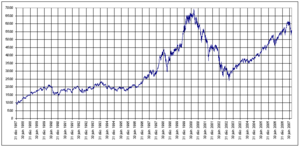The
CAC 40 (French: CAC Quarante), which takes its
name from the Paris Bourse's early automation system Cotation
Assistťe en Continu (Continuous Assisted Quotation),
is a benchmark French stock market index. The index represents
a capitalization-weighted measure of the 40 most significant
values among the 100 highest market caps on the Paris Bourse
(now Euronext Paris). It is one of the main national indices
of the pan-European stock exchange group Euronext alongside
Brussels' BEL20, Lisbon's PSI-20 and Amsterdam's AEX.
History

Price
evolution of the CAC 40 between 1987 and 2007
The
CAC 40's base value of 1,000 was set on 31 December 1987,
equivalent to a market capitalisation of 370,437,433,957.70
French francs.[2] In common with many major world
stock markets, its all-time high to date (6922.33 points)
was reached at the peak of the dot-com bubble in September
2000.[3] In 1 December
2003, the index's weighting system switched from being dependent
on total market capitalisation to free float market cap
only, in line with other leading indices.[4]
Rules
Selection
The
CAC 40 index composition is reviewed quarterly by an independent
Index Steering Committee (French: Conseil Scientifique).[2] If any changes are made, they are effected a
minimum of two weeks after the review meeting.[2]
At each review date, the companies listed on Euronext Paris
are ranked according to free float market capitalisation
and share turnover over the prior 12 months.[5]
From the top 100 companies in this ranking, forty are chosen
to enter the CAC 40 such that it is "a relevant benchmark
for portfolio management" and "a suitable underlying asset
for derivatives products".[5]
If a company has more than one class of shares traded on
the exchange, only the most actively traded of these will
be accepted into the index (generally this will be the ordinary
share).[5]
Weighting
The
CAC 40 is a market value-weighted index. The number of issued
shares (used to calculate the market cap and hence the index
weight) of a company is reviewed quarterly, on the third
Friday of March, June, September and December.[2] Since December 2003, the index
weightings of companies in the index have been capped at
15% at each quarterly index review,[5] but these range freely with share price subsequently.
A capping factor is used to limit the weights to 15% (if
necessary), and is reviewed annually by the Index Steering
Committee on the third Friday of September.[5]
Calculation
The
index value I of the CAC 40 index is calculated using the
following formula:[5]

with
t the day of calculation; N the number of
constituent shares in the index (usually 40); Qi,t
the number of shares of company i on day t;
Fi,t the free float factor of share i;
fi,t the capping factor of share i
(exactly 1 for all companies not subject to the 15% cap);
Ci,t the price of share i on day
t; Qi,0 the number of shares of
company i on the index base date; Ci,0
the price of equity i on the index base date; and
Kt the "adjustment coefficient for base
capitalization" on day t (reflecting the switch from
the French franc to the Euro in 1999).
Holdings
Although
the CAC 40 is almost exclusively composed of French-domiciled
companies, about 45% of its listed shares are owned by foreign
investors, more than any other main European index.[6]
German, Japanese, American and British investors are amongst
the most significant holders of CAC 40 shares. This large
percentage is due to the fact that CAC 40 companies are
more international, or multinational, than any other European
market. CAC 40 companies conduct over two thirds of their
business and employ over two thirds of their workforce outside
France.[7]
Composition
A list
of the CAC 40 companies, as of the quarterly review effected
on 18 July 2007. No changes have been made to the index
at the three subsequent reviews.[2]
Note
1: - Weightings accurate at close of trade on 3 December
2007.
References
External
links

